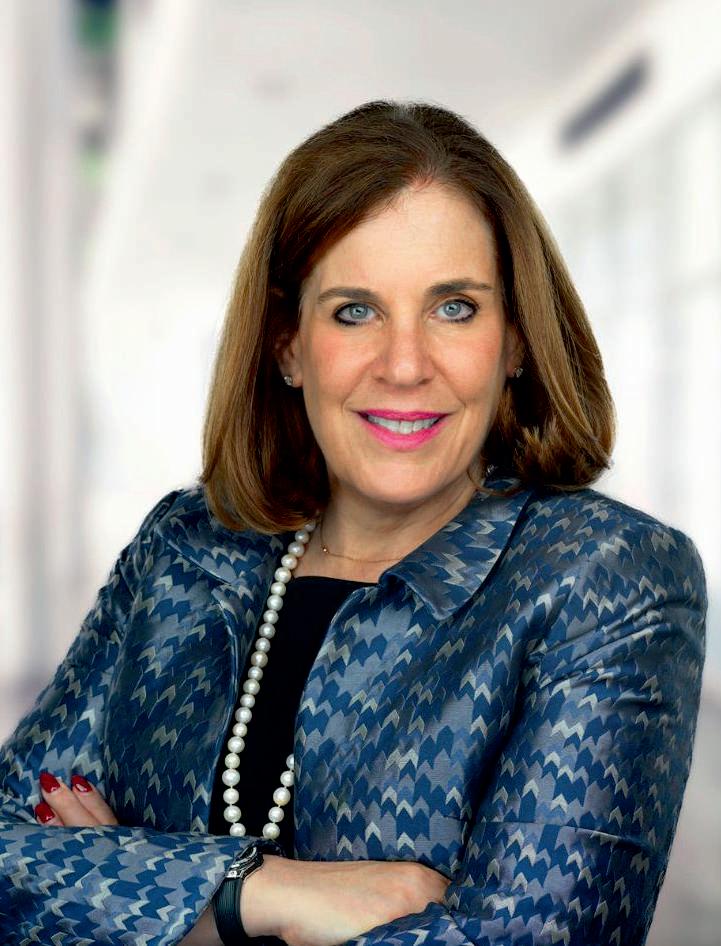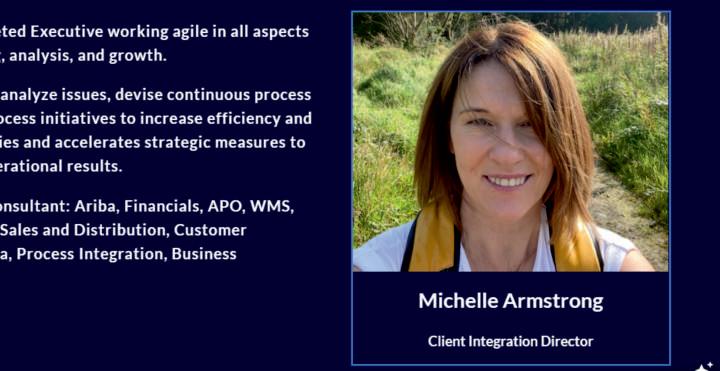THE MOST VISIONARY WOMEN LEADERS IN
CREATING GLOBAL IMPACT, 2024
From Automation to Augmentation: Transforming the Future of Work
Opportunities and Challenges in Implementing AI: Navigating the Path to Success Optimizing AI For Health Enquiry: The 5 Key Ingredients

LeeTiedrich
Distinguished Faculty Fellow in Law and Responsible Technology and Executive in Residence.




www.ciobusinessworld.com






Follow us : www.ciobusinessworld.com Editor in chief Robert Patrick Contents Managing Editor : Smith Collins Design Visualizer : Jack Thomas Arts & Design Director : Adam Jones Associate Designer : Erick Williams Sales Senior Sales Manager : Scott M Marketing Manager : Andrew T Sales Executive : Mark Davis Technical Victor Anderson SME- SMO Research Analyst : Henry Martinez SEO Executive : Daniel Lee Circulation Manager Alexander Nelson

Editorial Note
A Glimpse into AI's Visionary Leaders
The creative landscapes of
Artificial Intelligence have risen as a powerful source, shaping the trajectory of the project. Their leadership transcends boundaries, revolutionizing industries, propelling towards a future with innovation and inclusivity.
Right from research labs to boardrooms, these women are not just participants, but they are the architects of change, navigating the intersection of technology, ethics, and humanity. It is their impact that goes across all domains, from healthcare to finance and education to environmental sustainability. Because of their groundbreaking research, they are unfolding the mysteries of AI, unlocking the potential to handle most pressing challenges.

In the field of acamedics, luminaries like Dr. Fei-Fei Li, has showed her work in computer vision as well as AI ethics and Dr. Yoshua Bengio have inspired countless scientists, mostly women to pursue careers in AI. In the corporate world, leaders like Demis Hassabis, and co-founder DeepMind and Dr. Rumman Chowdhury, are the ones who are leading the ethical AI programs at major tech companies, showing how considerations are integral to AI.
Beyond the technical capability, the women leaders shows resilience, realizing the importance of diversity in AI. They have mastered initiatives to empower groups, ensuring that AI shows the richness of the human experience.
The way we celebrate the achievements, it is important to realize the challenges that continues to overcome. Above all the gender disparities exists even in the tech industry and biases in AI. Yet these leaders remain firm, harnessing the collective intellect to forge a more sustainable future.
Overall, AI transcends mere technology, it is also a force for positive transformation, thus amplifying human potential. Thus they navigate the challenges of the AIdriven world, let us now come together and draw inspiration from these women leaders, whose vision determines the path towards a brighter tomorrow.
As we reflect on the contributions of visionary women leaders in AI, let us also commit to amplifying their voices, dismantling barriers, and fostering an environment where talent and innovation know no gender. Together, we can harness the full potential of AI to create a future that is not only technologically advanced but also ethical, equitable, and sustainable.
Beyond the corporate sphere, community-driven initiatives play a crucial role in empowering women in AI. Networks, conferences, and mentorship programs tailored to women in the field provide invaluable support, networking opportunities, and resources for skill development and career advancement.
The way the corporate sphere, community-driven initiatives play an important role in empowering women in AI. Thus by embracing diverse perspectives as well as experiences, we can unlock AI's potential as a force of positive change, driving innovation, addressing the pressing challenges facing humanity. Overall we can build a future where AI shows the diversity and complexity of the world to serve, empowering all individuals to shape more inclusive society.
That is why we bring you forth, The 10 Most Visionary Women Leaders in AI creating Global Impact, 2024. Through this edition we acknowledge and address the challenges and achievements faced by these women in the field of AI.

10

Lee Tiedrich
18
ARTICLE
From Automation to Augmentation: Transforming the Future of Work
26 Opportunities and Challenges in Implementing AI: Navigating the Path to Success
32 Optimizing AI For Health Enquiry: The 5 Key Ingredients
22 AI: How engaging with schools is key to the future talent pipeline
28
Green House Gas Protocol – Scope 3 Emissions and Technological approaches to measure
CXO
Cover Story
Law and Responsible Technology and Executive In Residence





Lee Tiedrich
10










11 www.ciobusinessworld.com
Distinguished Faculty Fellow in Law and Responsible Technology and Executive in Residence.









12
LeeTiedrichisattheforefrontofhighstakesAI anddigitaltransformation.Workingatthe intersectionoftechnology,law,andpolicyfor morethanthreedecades,shehelpsgovernmentsandother organizationsunlockthebenefitsoftechnologyandmanage risksinarapidlychangingandincreasinglyregulatedand litigiousenvironment.Leesharesherinsightson responsibleAI,data,andemergingtechnologiesbuilding uponherexperienceadvisingcompaniesandherinnovative internationalpolicyworkatAI'sforefrontandher universitywork.Hermessagesemphasizetheglobaland multi-disciplinarynatureofAI,emphasizingtheimportance ofresponsibleandinclusivepractices.
AJourneyinLaw,AI,andResponsibleTechLeadership
Inthe1980s,Leeembarkedonanacademicjourneyat DukeUniversity,emergingasoneofthefewwomeninher classmajoringinelectricalengineering.Aftergraduating withhonorsfrombothDukeandtheUniversityof PennsylvaniaLawSchool,shedevotedthreedecadesto practicinglaw The22ndwomanelectedtothepartnership ofthegloballawfirmCovington&BurlingLLP,Lee's earlycareerfocusedonnavigatingclientsthroughthe transformativelandscapesofcellulartechnology,the internet,e-commerceandotheremergingtechnologies, eventuallyleadingtoherpioneeringworkinartificial intelligence(AI)anddigitaltransformation.
FollowingLee'sdistinguishedlawfirmcareer,she transitionedtoDuke'sfaculty,whereshebecamea trailblazerinmulti-disciplinaryresponsibleAI,data,and emergingtecheducation.Herworkalsocontinuedto includelawandpolicy,servingasanexpertforOECD.AI andco-chairingvitalcommitteeswithintheGlobal PartnershiponAI(GPAI),includingtheGPAIResponsible AIStrategyfortheEnvironment(RAISE)Committeeand theGPAIIntellectualPropertyAdvisoryCommittee.She haspresentedherworkinhighprofilevenuesinNorth America,Europe,andAsia.Shealsoadvisesgovernment, businessandotherleadersonhowtounlockAI'sbenefits
andnavigateitsrisksinourcomplex,regulated,andeverchangingworld,showcasingalifelongcommitmenttoand deepknowledgeandexperiencewithadvancingresponsible technologypractices.
StrategiesandSolutionsinLee'sExpertise
Leeexplainshowseveralstrategiesandprinciplesinform herwork.Sheunderscorestheimportanceofunderstanding broadlywhereresponsibletechnologystandstodayaswell aswhereitisheading.Tosupportherbroadvision,Lee drawsuponherdecadesofmulti-disciplinaryexperienceas wellashermarketunderstandingandherdeepengagements withmanydiverseglobalstakeholders.
Inadditiontobroadvision,Leeemphasizestheimportance offocusingondetails. Thisisvitalforaddressing complexitiesandcraftingsolutionsthatmeetthedesired objectivesandcomplywithlaws. Forexample,her pioneeringworkonAIanddatagovernanceisinformedby bothhermasteryofthequicklychangingbroadAIanddata landscapeaswellashermasteryofthemanydetailedlegal, policyandtechnicalissuesunderpinningit.
SeasonedcreativelyandjudgmentareessentialtoLee's strategies,too.Thishelpsherdevelopinnovative responsibleAIsolutionsdesignedtooptimizebenefitsand managerisks.
Emphasizingpracticality,Leeplacesafinalemphasison developingconcretesolutionsthatcanbeimplementedand operationalized,recognizingthatideasnottranslatableto practicecanhavelessutility.Inessence,herapproach underscoresacommitmenttoacomprehensive understanding,innovativeproblemsolving,andthetangible applicationofresponsible technologysolutions.



13 www.ciobusinessworld.com
CraftingAgileandEnduringLegalFrameworksforAI inaGlobalLandscape
LeeexplainsthatdevelopingeffectiveAIlegalframeworks presentschallenges. Ontheonehand,theframeworksmust endureandincreasecertainty.Ontheotherhand,the frameworksmustbecapableofadaptingtorapid technologicalchanges.LeeaddsthatAIlegalframeworks shouldincludebothbindinglawsandrules,whichtendto beenduring,aswellastechnicalstandards,guidance,and othertools,whichtypicallycanbeadaptedmorequickly. Toenhanceeffectiveness,theframeworksshouldboth incentivecomplianceandhaveappropriateenforcement mechanisms.
Sincetechnologydoesnotstopatborders,Leeemphasizes theimportanceoffosteringinternationalharmonization amongcountries.Oftentimes,lawsvaryamongcountries, andtechnicalstandardsandothertoolscanincrease harmonization. Multi-lateraleffortsandstandardsbodies haveakeyroleinadvancinginternationalharmonization.
DrivingSuccessandEthicalImperative
Diversityandinclusioncansignificantlycontributetoan organization'ssuccessinmanyways.Inadditiontohelping recruitandretainthebesttalent,diverseteamstendtobring broaderperspectivestoprojects,whichoftenleadtomore creativeandinnovativesolutions.Whenpeoplefeel includedandvalued,theytendtohavemoreloyaltyand commitmenttotheorganization,whichinturn,canenhance workquality. Recognizingthevalueofdiverseteams, manyclientsinsistonthem.
Equallyimportant,organizationsshould embracediversityandinclusion becauseit'stherightthingto do.Everyonedeservesa
fairandequalopportunitytogrowandexcel. It'ssimply wrongtodenyopportunitiestoanypersonbasedonrace, gender,sexualorientationorsomeotherprotected characteristic.
AdvocatingResponsibleAIPracticesforInclusive Benefit
Lee haspresentedherworkandengagedinmultistakeholderconversationsonaglobalscale,with participationineventsinEurope,Asia,theMiddleEast,and NorthAmerica.
Herexperiencesunderscoreoneofherfundamental messages–therecognitionthatAIconstitutesaglobaland multidisciplinaryfield.Theseopportunitiesalsoprovideher withinvaluableperspectivesonhowtounlockAI'sbenefits andmanagetherisksforeveryone. Nobodyshouldbeleft behind,includinghistoricallyunder-representedpeople.
ManyofLee'spresentationsfocusonresponsiblyunlocking thebenefitsandmitigatingtherisksofAIanddata.AIholds tremendouspotentialtoadvancesocialgood,including helpingaddressclimatechange,whichispartofLee'sGPAI work,healthcareandhelpingachievetheUNSustainable DevelopmentGoals.AIcanalsoadvanceglobalsecurity andprosperity. However,Leestressesthatallofthismust bedoneinawaythatprotectsindividualsandissafe,fair andequitable. SomeofLee'stalksfocusonstrategiesfor achievingtheseobjectives,bothatapolicylevelandwithin individualorganizations.
Leealsofrequentlypresentsonothertopics,includingAI andclimate,AIandintellectualproperty,AIandprivacy,as wellasstrategiesforenhancingresponsibleAIdataand modelsharing.Thesepresentationsoftendrawonworkher withOECDAIandGPAI.




14









15 www.ciobusinessworld.com
HelpingBoardsManageTechnology,Govrnance,, Sustainability,andDEI
Inherlegalpractice,Leegainedexpertiseadvising corporateandnon-profitboards.Shealsohasservedon boards.Lookingahead,Leehopestobeappointedtomore boards,andherexperiencepositionsherwellforthese roles.Boardshaveincreasingresponsibilitiestooversee technologymatters.Leebringstremendousexpertiseinthis area,aswellasingovernance,sustainability,anddiversity
NavigatingtheChallengesandOpportunities
TheintersectionofAIandglobalgovernancepresentsboth challengesandopportunities.Atthepolicylevel,countries areactivelydevelopingframeworkstounlockAIbenefits whilemanagingassociatedrisks.Multilateralorganizations liketheUN,G7,OECD,GPAI,NATO,amongothers,are strivingtofostergreaterinternationalregulatory harmonizationrecognizingtheborderlessnatureof technology.
Anotherchallengerestsindevelopingstandards,guidance, andtoolstooperationalizetheAIlawsandpoliciesin practice.Organizationsalsofacechallengesimplementing newAIlawsandpolicieswithintheiroperations,aswellas keepingpacewiththemanytechnical,legal,businessand otherchanges.
Addressingthesechallengesnecessitatesmulti-disciplinary collaborationandsolutions,bothgloballyandwithin organizations.It'salsocriticaltofactorinviewsof historicallyunder-representedgroupstoensurethat everyonebenefitsfromAIandisprotected againstrisks.GivenAI'sfastpaced, globalandmulti-disciplinary nature,opportunitiesexistfor everyonetoparticipate.
GuidanceonPassionandPersistence
Leeadviseswomenscienceandtechnologyleadersto discovertheirpassionandbuildtheirexpertisearoundit. TherearemyriadAIissuesdemandingattention.People tendtoenjoytheirworkandsucceedmorewhentheyfocus ontopicstheycareabout.Peopleshouldsetgoals,butnot getdiscouragediftheydon'talwaysachievethem. Persistencepays,andeveryonecanlearnfrommistakes.
Womenalsoshouldinvestinthemselves.Thisincludes pursuingopportunitiestoenhancetheirAIknowledge, experienceandprofile.Networkingalsoisimportant, includingtocultivatementorsandsponsorswhocan introducewomentoexcitingopportunities. Networking canalsoleadtonewclients,customers,orotherbusiness arrangements.
PioneeringWomeninTechnology
Leedrawsinspirationfromthemanywomenleadersacross technology,law,policy,economics,business,social sciences,andotherdisciplines,alreadyshapingthefutureof AIandtechnology.She'sequallyexcitedbythelarge numberoftalentedwomenstudentsandyoung professionalswhowanttomaketheirmarkinthisfield.She foreseestalentedwomenacrossgenerationshelpingmake thetechnologyindustrymoreinclusiveforeveryoneand enhancingresponsibleinnovation.




16


From Automation to Augmentation: Transforming the Future of Work
18 ARTICLE
Inrecentyears,theriseofautomationhassparked debatesaboutitspotentialimpactontheworkforce, withconcernsaboutjobdisplacementandtheerosion oftraditionalroles.However,ashiftisunderwayaswe movefromviewingautomationasathreattoembracingit asatoolforaugmentation,enhancinghumancapabilities andreshapingthenatureofwork.Thistransitionholdsthe promiseofunlockingnewopportunities,fostering innovation,andempoweringworkerstothriveinthedigital age.
Automation,poweredbyadvancementsinartificial intelligence,robotics,andmachinelearning,hasalready revolutionizedmanyindustries,streamliningprocesses, increasingefficiency,anddriving productivitygains.Whilesome tasksmaybecomeautomated,the focusisincreasinglyshifting towardsleveraging automationtoaugment humancapabilities, ratherthanreplace thementirely This approachrecognizes thathumanspossess uniqueskills,suchas creativity,empathy, andcomplex problem-solving,that aredifficultto replicatewith machines.
Augmentationinvolves integratingautomation technologiesintoworkflowsto enhancehumanperformance,enable newwaysofworking,andunlocknew possibilities.Forexample,in healthcare,AI-powereddiagnostic toolscanassistphysiciansin analyzingmedicalimagesand identifyingpatternsthat maybe imperceptible tothe
humaneye,leadingtomoreaccuratediagnosesandbetter patientoutcomes.Similarly,inmanufacturing,collaborative robots,orcobots,canworkalongsidehumanworkersto performrepetitiveorphysicallydemandingtasks,freeing themtofocusonmorecomplexandvalue-addedactivities.
Theshiftfromautomationtoaugmentationalsorequiresa reimaginingofeducationandtrainingsystemstoequip workerswiththeskillsandcompetenciesneededtothrive inadigitaleconomy.Thisincludesfosteringdigitalliteracy, criticalthinking,adaptability,andlifelonglearning,aswell asprovidingopportunitiesforupskillingandreskillingto meetevolvingjobdemands.Byinvestinginhumancapital development,wecanensurethatworkersarepreparedto harnessthepotentialofautomationandnavigatethe changinglandscapeofwork.
Furthermore,thetransitiontoaugmentationpresents opportunitiesforbusinessestoinnovateandcreatenew valuepropositions.Byintegratingautomationtechnologies intotheiroperations,organizationscanoptimizeprocesses, improvecustomerexperiences,anddrivegrowth.For example,inretail,AI-poweredchatbotscanprovide personalizedrecommendationsandsupporttocustomers, enhancingengagementandloyalty.Infinance,automated algorithmscananalyzevastamountsofdatatodetect fraudulentactivitiesandmitigaterisks,safeguardingthe integrityoffinancialsystems.
However,asweembracethepotentialofaugmentation,itis essentialtoaddresspotentialchallengesandrisks,including concernsaboutjobdisplacement,inequality,andethical considerationssurroundingtheuseofautomation technologies.Thisrequiresproactivemeasurestoensure thatthebenefitsofaugmentationareequitablydistributed andthatworkersaresupportedthroughperiodsof transition.Italsonecessitatesethicalframeworksand guidelinestogoverntheresponsibledevelopmentand deploymentofautomationtechnologies,ensuringthatthey alignwithsocietalvaluesandrespecthumandignity.
Inconclusion,thetransitionfromautomationto augmentationrepresentsaparadigmshiftinhowwe perceiveandharnesstechnologyintheworkplace.By embracingautomationasatoolforaugmentation,wecan unlocknewopportunities,enhancehumancapabilities,and createafuturewherehumansandmachinescollaborate synergisticallytodriveinnovationandprosperity.However, realizingthisvisionrequirescollectiveaction, collaboration,andacommitmenttoensuringthatthe benefitsofaugmentationaresharedbyall.
19 www.ciobusinessworld.com




Thelettersonallourmindsareofcourse AI andwhatitmeansforourbusinesses andourtechnologyteams.Whatskills willbeneededinthefuture,andhowdowe prepareourbusinessesforthatfuture?
While AI mightbebusyrevolutionisinghowwe work,howweinteract,andhowwerunourlives, thereisonecriticalthingit'snotgoingtochange unlessweactquickly.Rightnow,weare experiencingacrisisaroundskillsgapsindigital, techandtechadjacentroles.Allresearch companies,recruiters,andmanagement consultantstellusthatthetechnologyskillsgapis onlygoingtowiden.Simply,morepeopleneed betterdigitalskillsandtheabilitytowork confidentlywith AI asitaugmentsandenhances theirroles.
There'salsoacompellingneedfortechnology anddatateamstobefarmorediversethanthey currentlyare.Themostproductiveand performantbusinessesneedtohaveteamsthat matchthedemographicoftheircustomersand citizens-notjusttobecompetitive,butalsoto avoidunintendednegativeconsequencesinthe AI drivenservicesbeingcreated.Despitemore than20yearsoftargetedinterventionsby progressivebusinessestorecruitinclusively,to createsupportiveenvironments,encourageearly careers,continuouslearningand'squiggly' careers,diversitylevelshaven'treallychanged.
Startingyoung
Didyouknowthatchildrencanmakecareerlevel typedecisionsasyoungasfiveyearsold?Also, betweenleavingprimaryandsecondaryschool children'sviewsonwhichcareersare'forthem' continuetonarrowastheyareinfluencedbytheir families,communities,teachers,andpeers.They thennarrowagainwhentheypick GCSEs, usuallytotryandmatchaverysmallnumberof careeroptions.
Howtomakeschoolsengagementpartofyour talentmanagementprogramme
Acrucialbutoftenunder-developedcomponent ofstrategictalentmanagementprogrammesisthe implementationofavolunteeringschemethat workswithschoolstoinspirenewgenerationsto jointhetechworkforceinthefuture.Notonly canthiscreateabiggerpooltorecruitfrom,buta well-designedschemefocusingonyoungpeople fromdisadvantagedorunder-representedgroups canalsocreatealargeanddiversepipelineof previouslyuntappedtalent.Itcanalsocreatea double-digitsocialvaluereturnoninvestment, nottomentionengaged,confidentandmotivated employees.
Partneringwithorganisationswhoaretrusted adviserstoteachersandschoolscanaccelerate impactbothontheimmediateandlong-term
22 CXO

23 www.ciobusinessworld.com

talentpipeline,aswellasdelivermeasurable socialvalueatnationalandlocallevelsinterms ofaddressingsystemicissuessuchassocial mobility.
Sustainablevolunteeringprogrammesinschools areeasytoimplementandmanageifan educationalpartnerlike STEM Learningisused. Youdon'tneedtostartfromscratch.Thefreeto use STEMAmbassadorsplatformhasa ComputingAmbassadorschemewhichguides andsupportsindividualsandorganisations throughthevolunteeringprocess.
Youremployeescan:
Ÿ Quicklyregisterandundertaketherequired45 minutesoftrainingwhichincludes safeguardingtraining
Ÿ Getafree DBS checkorsharetheir DBS certificateiftheyalreadyhaveone
Ÿ Freeaccesstoarangeofself-pacedand remotelydeliveredtrainingsuchasplanning anddeliveryanactivity,howtotalk inclusively,howtoengagevirtuallyinan impactfulwayandmanymore
24

Ÿ Freeaccesstoadigitalcommunityofother volunteerssupportingeachother
Ÿ Freeaccesstotemplated,triedandtested, impactfulschoolactivities
Ÿ Freeaccesstoa'marketplace'whereteachers askforvolunteerstosupportthemwith specificasks(suchascareerseventsorto supportacompetition),andwherevolunteers cansharetheirofferstoteachers
Ÿ Freepersonalsocialimpactscorebasedonthe activitiesloggedontheplatform
Ifmorethan25ofyouremployeesregisterand logatleastoneactivityevery12months, STEM Learningcancreateadatasharing agreementwhichwillgiveyouaccesstoa consolidatedsocialimpactreportforallthe volunteeringworkreportedbyyouremployees ontheplatform.
Itreallyisthatsimpletogeneratesocialvalue impact,buildadiversefuturetalentpipeline, helpyourearlycareeremployeesdevelopkey businessskills-andultimatelyincreaseboth employeeretentionandproductivity.
Tobetterrepresenttheworldwelivein,we needtocontinuetochallengeanddiversify theindustry.Thisstartsinschools.Joinus! employers@stem.org.uk
Bio: Dr Nicki Clegg has over 30 years of experience as a technologist and 15 years as strategist and senior leader. She was a Chief Technology Officer for almost five years before deciding to focus fully on driving social mobility, diversity and inclusion in technology. She is now Industry Stakeholder Relationship Manager for STEM Learning helping deliver the National Centre for Computing Education (NCCE). Her role raises awareness of the NCCE and increases business engagement with schools and young people to help inspire a new and more diverse generation into careers in technology
25 www.ciobusinessworld.com
26 ARTICLE
Opportunities and Challenges in Implementing AI:Navigating the Path to Success
ArtificialIntelligence(AI)presentsamyriadof opportunitiesforbusinesses,governments,and societyatlarge,offeringthepotentialtostreamline operations,enhancedecision-making,anddriveinnovation. However,alongwiththeseopportunitiescomesignificant challengesthatmustbenavigatedtorealizethefull potentialofAI.Understandingboththeopportunitiesand challengesisessentialfororganizationsseekingtoleverage AIeffectivelyandresponsibly
Opportunities:
1.IncreasedEfficiency:AItechnologiescanautomate repetitivetasks,optimizeprocesses,andimprove productivity,allowingorganizationstoallocateresources moreefficientlyandfocusonhigher-valueactivities.
2.EnhancedDecision-Making:AI-poweredanalyticscan analyzevastamountsofdata,uncoverinsights,andprovide predictivecapabilities,enablingbetter-informeddecisionmakingandmoreeffectivestrategicplanning.
3.PersonalizedExperiences:AIalgorithmscananalyze userdatatodeliverpersonalizedrecommendations,content, andservices,enhancingcustomerexperiencesanddriving engagementandloyalty.
4.InnovationandCreativity:AIcanaugmenthuman creativitybygeneratingnovelideas,assistingindesign tasks,andfacilitatingcollaboration,fosteringacultureof innovationwithinorganizations.
5.ImprovedHealthcareOutcomes:AI-driven diagnostics,predictiveanalytics,andpersonalizedtreatment planshavethepotentialtorevolutionizehealthcare,leading toearlierdetection,moreaccuratediagnoses,andbetter patientoutcomes.
Challenges:
1.DataQualityandBias:AImodelsareonlyasgoodas thedatatheyaretrainedon,andbiasedorincompletedata
canleadtoskewedresultsandperpetuateinequalities. Ensuringdataqualityandaddressingbiasiscrucialforthe ethicalandresponsibleuseofAI.
2.EthicalConcerns:AIraisescomplexethicalissues, includingconcernsaboutprivacy,transparency, accountability,andtheimpactonjobsandsociety Organizationsmustconsidertheethicalimplicationsof theirAIsystemsandimplementsafeguardstomitigate risks.
3.TalentShortage:ThereisagrowingdemandforAI talent,includingdatascientists,machinelearningengineers, andAIethicists,butashortageofskilledprofessionalsin thesefields.BuildingadiverseandinclusiveAIworkforce isessentialfordrivinginnovationandaddressingemerging challenges.
4.RegulatoryandLegalUncertainty:Therapidpaceof AIinnovationhasoutpacedregulatoryframeworks,leading touncertaintyaboutlegalandethicalstandardsforAI deployment.Clearregulationsandguidelinesareneededto ensurethatAItechnologiesaredevelopedandused responsibly
5.SecurityandPrivacyRisks:AIsystemsarevulnerable tocyberattacks,databreaches,andadversarialattacks, posingriskstosensitiveinformationandcritical infrastructure.Robustcybersecuritymeasuresandprivacy protectionsareessentialforsafeguardingAIsystemsand maintainingtrust.
NavigatingtheimplementationofAIrequiresorganizations tostrikeabalancebetweenleveragingtheopportunitiesit presentsandaddressingthechallengesitposes.This involvesinvestingintalentdevelopment,prioritizing ethicalconsiderations,collaboratingwithstakeholders,and embracingacultureofresponsibleinnovation.By proactivelyaddressingtheseopportunitiesandchallenges, organizationscanharnessthetransformativepowerofAIto drivesustainablegrowth,improveoutcomes,andcreate valueforsociety.
27 www.ciobusinessworld.com
GreenHouseGasProtocol–Scope3Emissionsand Technologicalapproaches tomeasure
Scope3emissions,oftenreferredtoas“valuechain emissions,”areapartoftheGreenhouseGas Protocol'scorporatestandardforgreenhousegas accounting.Theseemissionsaregenerallythemost significantshareofanorganization'scarbonfootprintbut arealsothemostcomplextomanageandmitigate,asthey involveactivitiesnotdirectlyownedorcontrolledbythe reportingcompany.Scope3includesbothupstreamand downstreamemissionsandencompassesawiderangeof indirectemissionssources.
TheregulationsandguidelinesaroundScope3emissions varydependingontheregionandthespecificregulatory framework.However,therearesomegeneralaspectsto consider:
Ÿ Voluntaryvs.MandatoryReporting:Inmanyregions, reportingScope3emissionsisstillvoluntarybutis increasinglybeingencouragedorrequiredaspartof broadersustainabilityreportingframeworks.For example,theEuropeanUnion'sNon-Financial ReportingDirective(NFRD)encouragescompaniesto reportontheirScope3emissions.
Ÿ StandardsandProtocols:TheGreenhouseGas Protocolprovidesthemostwidelyusedinternational accountingtoolforgovernmentandbusinessleadersto understand,quantify,andmanagegreenhousegas emissions,includingScope3.
Ÿ CorporateSustainabilityReporting:Companiesmay choosetoreportScope3emissionsaspartoftheir sustainabilityorcorporatesocialresponsibility(CSR) reporting.Thisisoftendonetoimprovetransparency, managerisks,andidentifyopportunitiesforreducing emissionsinthesupplychain.
Ÿ InvestorandStakeholderPressure:Thereis increasingpressurefrominvestors,customers,andother stakeholdersforcompaniestoreportandreducetheir Scope3emissions.Thispressureoftendrivesmore detailedandrigorousreportingandreductionstrategies.
Ÿ Sector-SpecificGuidelines:Certainindustrieshave specificguidelinesorexpectationsforScope3 reporting.Forexample,theScienceBasedTargets initiative(SBTi)providesmethodsandguidancefor companiestosetscience-basedtargetsforreducing greenhousegasemissions,includingScope3.
Ÿ LocalandNationalRegulations:Somecountrieshave specificregulationsorguidelinesforScope3reporting. Thesecanvarysignificantlyandmaybemoreorless stringentthaninternationalstandards.
Ÿ IntegrationwithBroaderESGGoals:Scope3 emissionsreportingisoftenpartofbroader environmental,social,andgovernance(ESG)strategies andgoalswithinorganizations.
TechnologicalApproachesforMeasuringScope3 Emissions
MeasuringScope3emissionsinvolvescomplexdata collectionandanalysisduetothebroadrangeofindirect emissionsourcesacrossacompany'svaluechain. Technologyplaysacrucialroleinthisprocess,withseveral keyapproaches:
Ÿ LifeCycleAssessment(LCA)Tools:Thesesoftware toolsanalyzetheenvironmentalimpactsofproductsor servicesthroughouttheirentirelifecycle,fromraw materialextractiontodisposal.LCAtoolscanbe


28
CXO


29 www.ciobusinessworld.com

Ÿ instrumentalinquantifyingScope3emissionsrelatedto productuseandend-of-lifestages.
Ÿ SupplyChainAnalysisSoftware:Theseplatforms focusonmappingandassessingemissionswithina company'ssupplychain.Theyhelpidentifyhotspotsof highemissionsandopportunitiesforreductionby analyzingsupplierdataandactivities.
Ÿ CarbonAccountingPlatforms:Thesecomprehensive toolsenablecompaniestotrackandmanagetheircarbon emissionsacrossallscopes,includingScope3.They oftenfeaturedashboards,reportingcapabilities,and scenarioanalysistosupportstrategicdecision-making.
Ÿ EnergyManagementSystems(EMS):While primarilyfocusedondirectenergyconsumption(Scope 1and2),EMScanalsocontributetoScope3analysis byprovidinginsightsintotheenergyuseandassociated emissionsofleasedassets,franchises,andoutsourced activities.
Ÿ BlockchainandIoT:Emergingtechnologieslike blockchainandtheInternetofThings(IoT)offernew waystotrackandverifyemissionsdataacrosscomplex supplychains,enhancingtransparencyandaccuracy
DataSourcesforScope3EmissionsMeasurement
Scope3reportingplatformsgatherdatafromavarietyof sources:
Ÿ SupplierSurveysandSelf-Reporting:Direct communicationwithsupplierstocollectdataontheir emissionsandenvironmentalpractices.
Ÿ IndustryAveragesandBenchmarks:Utilizing establisheddatabasesandbenchmarkstoestimate emissionsforcommonprocessesorproductsinthe absenceofspecificdata.
Ÿ PublicandProprietaryDatabases:Accessing governmentorcommercialdatabasesthatprovide emissionsfactorsandenvironmentalimpactdatafora widerangeofactivitiesandmaterials.
Ÿ SensorandIoTData:Collectingreal-timedatafrom sensorsandIoTdevicesembeddedinproductsorsupply chainoperationstomonitoremissions.

Specialities: Strategic Leadership • Digital Transforma functional consultant (APO, Hana, BI, WMS, S&D) • Sustainability, Human Rights and Modern Slavery, Mgmt. • Customer Relationship Mgmt.
30
Ÿ ReliabilityandApproaches
ThereliabilityofScope3measurementcanvary significantlybasedonthedataquality,themethodologies used,andthecomprehensivenessoftheanalysis. Approachesthatincorporateprimarydatafromdirect suppliersanduserobust,widelyrecognizedmethodologies (likethoserecommendedbytheGreenhouseGasProtocol) tendtobemorereliable.However,evenwiththebesttools andintentions,Scope3measurementsofteninvolvea degreeofestimationanduncertainty,especiallywhen relyingonsecondarydataorindustryaverages.
Watch-OutsWhenSourcingScope3Reporting Software
Ÿ DataQualityandTransparency:Ensurethesoftware supportshigh-quality,verifiabledatacollectionand offerstransparencyaboutitsmethodologiesanddata sources.
Ÿ CustomizationandScalability:Theplatformshould beadaptabletoyourspecificindustryandsupplychain complexityandscalableasyourbusinessandreporting needsevolve.
Ÿ IntegrationwithExistingSystems:Thesoftware shouldintegrateseamlesslywithyourexistingERP, CRM,andothermanagementsystemstostreamlinedata flowandavoidsilos.
Ÿ ComplianceandStandardsAlignment:Verifythatthe softwaresupportscompliancewithrelevantregional regulationsandalignswithinternationalstandardslike theGreenhouseGasProtocol.
Ÿ UserSupportandTraining:Adequateusersupport, training,andresourcesareessentialtoensurethe successfulimplementationandongoinguseofthe platform.
Inconclusion,technologyofferspowerfultoolsfor measuringScope3emissions,butthechoiceofplatform andapproachrequirescarefulconsiderationofyour company'sspecificneeds,thequalityandsourceofthedata used,andtheabilitytointegrateandalignwithbroader sustainabilitygoals
MichelleArmstrong–GlobalVPValueSolutions
Michelle.armstrong@TrustYourSupplier.com
https://www.linkedin.com/in/michelle-armstrong-ab895a32/ https://trustyoursupplier.com/
ormation • Blockchain • SAP platform
• Compliance regulations (focus on Cyber, Financial risk) • Implementation

31 www.ciobusinessworld.com



The5Key Ingredients
Atremendouspotentialtoimprove healthcareandpublichealthoutcomes. Butifnotdevelopedthoughtfullywithequityin mind,AIrisksexacerbatingdisparities.Hereare fivethingstoknowaboutensuringAIpromotes healthequity:
AIcanrevealhealthcaredisparities.
Byanalyzinglarge,diversehealthdatasets,AI systemscanuncoverdifferencesinaccess, treatment,andoutcomesacrossdemographics thatmayotherwisegounnoticed.Forexample,an algorithmmayfindracialdisparitiesincardiac carebyminingelectronichealthrecords.These insightsallowtargetingofsolutionsto disadvantagedgroups.
AImodelscanperpetuatebias.
BecauseAIlearnsfromdata,modelstrainedon historicallybiaseddatasetsmay disproportionatelymisdiagnose,underserve,or negativelyimpactmarginalizedpopulations. Studieshavefoundautomatedsystemsthat exhibitgenderandracebias.Ongoingbias monitoringandmitigationiscrucialthroughout developmentanduse.
Human-AIcollaborationcancounteractbias.
AIsystemsthatcombinehumanexpertisewith machinelearningnotonlyimproveperformance buthelpaddressalgorithmicbias.Humans providecontextandequity,whileAIaddsspeed andscale.Thisbalancedapproachprevents marginalizedgroupsfrombeingoverlooked.
Diversityindataandteamsenablesequity.
TodevelopequitableAI,diversereal-worlddata andperspectivesareneeded.Inclusivedata collectionandhavingrepresentativeteams involvedindesign,validation,andevaluation helpsbuildsensitivitytodifferentpopulations intosystems.
Post-deploymentauditsupholdfairness.
Ongoingtestingfordiscriminationandregular algorithmicimpactassessmentsafter implementationarekeytoensuringAIfairnessin practice.Thisallowspromptidentificationand correctionofemergentbiasesassystemsareused inchangingrealenvironments.
TheincreasinguseofAIinmedicineholdsvast potentialtoimprovecare,butthoughtfully embeddingequityconsiderationsthroughits developmentandapplicationiscrucialtotruly benefittingallpatients.Thisrequires conscientiouseffort,buttherewardswillbemore informed,just,andcompassionatehealthcarefor all.
32 ARTICLE

33 www.ciobusinessworld.com

















































